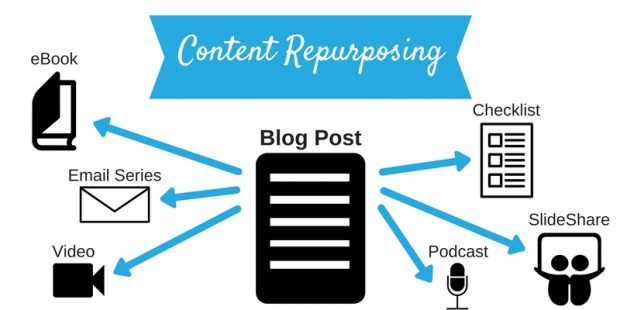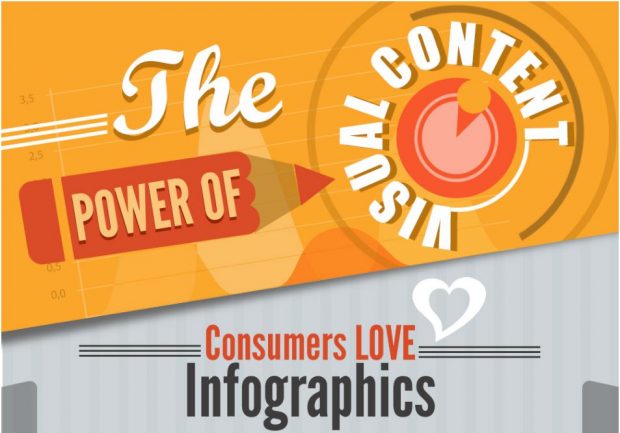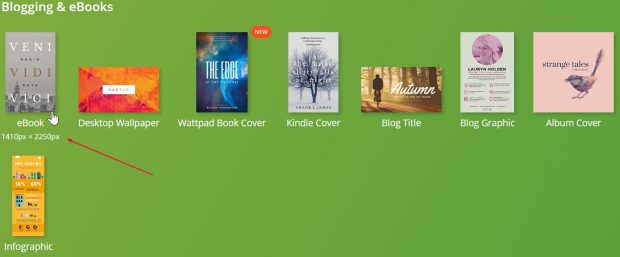If you’re anything like me, you spend a lot of time creating your content.
You’ve heard, like I have, that the key to content marketing is creating high-quality, in-depth content—which takes time.
What if I told you there’s a way you can get more shares, traffic, and leads from the same content you spent so much time on—with minimum extra effort?
It’s true, there is a way! You simply have to repurpose your content.
Jay Baer, founder of Convince and Convert, told me: “The key to repurposing content in social isn’t at the execution layer, it’s psychological. A blog post isn’t a blog post, it’s just a blog post at the BEGINNING. Smart marketers think of concepts and stories as just that—concepts and stories—that can take any form. You can take that blog post and make it a GIF, or a Periscope, or a Tweet, or an Instagram Story, or an infographic, or a podcast. Create once and repurpose everywhere: that’s the secret!”

Before we talk about how to do it, let’s talk about something more important: why.
Benefits of repurposing content
Repurposing your blog posts or videos does some amazing things. It can:
- Increase your social reach. By creating content in different formats, you’ll reach more audiences. The more variations you create, the more audiences you’ll reach, and the greater chance your content will be shared. Repurposing a blog post into a Facebook video, for example, could lead to a 62 percent increase in engagement (compared to sharing a post with a photo).
- Boost your SEO. Links back to your website and increased traffic will help with SEO. Additionally, more content means more opportunities to receive backlinks!
- Hammer home your main points. They say repetition is the root of all learning. By providing your content in multiple formats, you’ll ensure your readers take away the key points.
- Gain authority in your industry. When people see your name or brand in multiple places on in-depth content, they will see you as an authority.
These all sound great, but how do you know which content to repurpose? Where should you spend your time?
Types of content worth repurposing
Of course, not all content is created equal.
Some get more shares, some are crafted with more inspiration, and some are better able to convey great info.
Here are the types of content you should repurpose:
Evergreen content
Evergreen content is your golden goose—it’s the content that just keeps giving.
Posts that are always relevant, regardless of how much time goes by, are considered evergreen content. This often includes posts that go back to the fundamentals, as well as how-to content.
If you have any posts like that, they’re prime candidates to repurpose into other forms.

Digital marketing agency Koozai’s post about creating content offers a great opportunity for repurposing.
Koozai could turn their post into an amazing SlideShare presentation (which they have). They could also turn it into a cheat sheet to capture more leads, a sexy infographic, or even a short eBook… but, more on that later.
Popular content
If you had a blog post go viral, it’s the perfect candidate for recycling.
But, that bodes the question: what counts as “viral”?

You’re the only one who can answer that. Viral to BuzzFeed could mean 20,000 shares. Viral to a small blog with 10 daily visitors could mean 10 shares.
Basically, look for the posts that stick out. The ones that got a lot of traffic, shares, or engagements relative to your other posts.
If it got some traction, chances are people will dig it as in other forms as well.
Content you can expand on
If you don’t have evergreen content and haven’t received a lot of traffic on your current posts, you might be wondering what content you can repurpose.
Look at all your posts. Could you add to them? Perhaps add more resources, some relevant images or charts, or a section expanding on certain parts of the topic?
Take the post you’re reading right now, for example. I could turn it into an eBook and add more examples of brands repurposing content or just expand upon each step to show you exactly how to do it. Heck, I could even create a video series of me actually taking a piece of content and repurposing it.
Tweets or posts that got a lot of engagement
Look at your social media accounts. Did something you posted get a particularly large amount of shares or comments?
If so, then you may have struck content gold.
Take the Tweet above, for example. It’s from April, 2016 and at the time six Retweets and six likes was a lot for me. That could signify a high level of interest in the topic.
If it seems familiar, that’s because it is. I’m here writing about it right now.
The best part is that you can reach out to the people who engaged with your post once you’ve written the resulting content. They’re likely to share that as well.
Words of wisdom from leading experts
I asked Neil Patel, declared by Forbes as one of the top 10 internet marketers, to give me a few words of wisdom on the topic. He told me: “When possible you should share your content on as many social sites as possible. Google doesn’t penalize for duplicate content, so might as well get the most play from your content.”
Next up, I asked Sam Hurley, ranked the No. 1 digital marketer in the world by Webinale, what his best advice was on the topic. He said: “Never, ever, EVER just write an article and be done with it! The hours invested in one piece of content can eternally harvest a return. Utilize all forms of multimedia whenever possible.”
Finally, Sujan Patel, a growth hacker and marketer who’s worked with companies like LinkedIn and Yahoo!, had this to say: “I’m a big fan of repurposing content and love squeezing every drop out of my content marketing efforts. People learn and absorb information in different ways and formats so you might as well create those formats based off your best (and proven) content.”
The experts all believe wholeheartedly in repurposing content.
Now, you know the why. Next up: how.
11 ways you can repurpose content with minimal effort
So, you’ve found a few posts to repurpose. What do you turn them into?
Podcasts or audio blogs
If you have a decent microphone, you can record yourself reading your blog post out loud to create an audio blog for your website. This is a great way to give visitors multiple ways to consume your content and can be particularly useful if they’re on the go or at the gym.

Alternatively, you can use your blog post as a base and record a podcast episode on the same topic, but more off-the-cuff. This allows you to create unique content and gives visitors an incentive to read and listen.
You can use a free program like Audacity to record and edit your sound. Once you’ve created your episode, you can use SoundCloud to host it for free. Alternatively, Pat Flynn of Smart Passive Income made a sweet podcast hosting platform called Smart Podcast Player that only costs $8 per month.
Flynn also created a step-by-step guide to starting a podcast if you need more help.
Infographics
Infographics, when done right, can be a massive traffic boost for your website.
They tend to be shared (and read) more often than blog posts due to their visual nature. In fact, what better way to explain the effectiveness of an infographic than with an infographic?

When you’re ready to create your first infographic, you can use a tool like Venngage for free. They have templates you can choose from, but be aware the free version is fairly limited.
Personally, I love using Canva to create infographics. They have a variety of templates to choose from, and it’s free (with a paid version offering more options). It’s an amazing tool.
Alternatively, you can hire someone to create a custom graphic for you through a freelance marketplace like Fiverr or UpWork.
Slideshows
Slideshows are a great visual way to convey information and repurpose content. One of the most popular destinations for slideshows is SlideShare, which is owned by LinkedIn.
In fact, SlideShare is one of the top 100 most-visited sites in the world. With over 70 million visitors, you have a good chance to see some serious extra traffic if you post a good slide deck.
For example, I turned my free eBook (The Building Blocks of Content Marketing) into a SlideShare, which linked back to my landing page and got me a few extra subscriptions.
The following SlideShare shows you how to create a great SlideShare:
You can use PowerPoint, Apple Keynote, or Google Slides to create your SlideShare. Personally, I love using Canva.
If you need inspiration, check out this list of the best social media SlideShares from 2015.
Pro Tip: You can use Pay With A Tweet and DropBox to create a button on your slide deck that allows users to download your slides by sharing them in a Tweet. This tactic further increases your social reach. I did that on the last slide of my slide deck:

Videos
If you’re not camera shy, and have a decent microphone, videos can be a great alternative way to repurpose and enhance your content.
I say microphone because audio quality matters more than video quality. These days, smartphone cameras are good enough to shoot great video but their microphones leave a lot to be desired.
For a great example of recycling content into video to enhance a post, check out Sujan Patel’s article (and included video) on how to land guest posts on publications like Inc. and Entrepreneur.
If you need extra help actually creating the video, Social Media Examiner has an excellent guide.
Videographic
If you’re camera shy, or simply feel your content would be better presented graphically, a videographic (or animated infographic) is another excellent option.
Keeping with my trend, here’s a videographic about what goes into creating videographics:
You can create videographics using Adobe Illustrator and Adobe After Effects, both of which have a free trial. Alternatively, you can try a free tool like Biteable, although the free version is very limited.
However, it’s important to note that this process can be very time-consuming and has a steep learning curve if you’ve never done it before.
If you don’t have the time or patience to create something like this, your next best bet is to hire someone on Fiverr or UpWork for $20 to $100.
Webinars
John Lee Dumas, the mastermind behind the Entrepreneur on Fire podcast, always repeats one phrase:
“Sales happen on live webinars!”
It’s so true. And what better way to design a webinar than to base it around existing strong content?
It makes your life easier—you don’t have to spend as much time researching and creating—and it’s on an already proven topic.

If you believe creating a webinar is right for you, Mary Jaksch wrote an awesome, incredibly in-depth guide to running your first webinar without any expensive tools over on SmartBlogger.
Email series
Email marketing has long been the king when it comes to ROI per dollar.
In fact, check out this chart from the 2015 Infusionsoft Small Business Marketing Report showing the most effective sales and marketing strategies:

Email comes in at No. 2 under word-of-mouth marketing (WOM always wins because it’s built on reputation, rather than interruption marketing). Email also ties in really well with your social media strategy.
If you aren’t already building an email list, what are you waiting for? Go create a free MailChimp account right now (or Aweber, Constant Contact, etc).
When it comes to repurposing content, email series are a perfect channel. You can take an eBook or even a long blog post and split it into several parts which you send out to your email list over a few days or weeks.
If the thought of creating an email series tickles your fancy, go follow Aweber’s guide to repurposing content for an email series.
eBooks
Ah, eBooks—one of the wonderful things of the internet.
They’re (fairly) easy to create and have a virtually unlimited shelf-life. If you create an eBook based on your evergreen content, it can become the gift that keeps on giving.

One thing I love doing is purposefully creating blog posts with an eBook in mind as the end goal. But I’ll talk about that in the “What’s next?” portion of this guide.
For now, you can just choose some of your current content to repurpose into an eBook. Once you’ve chosen your piece, be sure to add to it and make it unique (don’t just copy-paste).
You can use Word, Pages, or Google Docs to create your book. Personally, I prefer PowerPoint because you can easily add and arrange images and make a template for every page.
Oh, and you can use Canva’s eBook template to create a cover page (aren’t they awesome?)

Content communities
While not exactly “content repurposing” per say, content communities are a good way to reach a new audience with your content.
Basically, a content community is a place where people go to find good content based on their interests.
To post to a content community, you simply provide a link back to your article with a brief summary.
To post to a content community, you simply provide a link back to your article with a brief summary.
For example, Inbound.org allows you to share articles related to marketing:

Some other great content communities (free and paid) include:
Online magazines and publications
Online magazines are probably something you never thought of when it comes to reusing your content. I know I didn’t.
However, they can be a great way to increase your social reach and hit an audience you may have never gotten to before.
Basically, when you upload your content to an online publication, it turns your content into a digital magazine. Pretty cool, right?
Here’s an example of an eBook I uploaded to Issuu:

They have a free plan, but (as I’m sure you guessed) it’s pretty limited. The most frustrating thing is that links in the document won’t work in the free version. The premium plan is $35 per month.
Some other publications include:
Content Upgrades
Last, but not least, we have content upgrades.
A content upgrade is a free download you give to your audience in exchange for their email, like a cheat sheet, template, or guide. However, they’re different than site-wide lead magnets in that they are specific to the piece of content your visitor is currently reading.
For example, if you wrote a blog post with 10 steps to growing your email list, you might include a content upgrade in the form of a checklist to help your reader get through all 10 steps.
I love content upgrades because they’re an amazing way to capture leads. They’re highly relevant and make an obvious next step.
To repurpose your content into a content upgrade, you can just take your post and turn it into an actionable cheat sheet or template.
Once you’ve created it, upload it to your content management system (CMS), like WordPress, and use your email client (like MailChimp) to create an opt-in form.
If you need help creating the upgrade and email responder, I wrote a step-by-step guide to creating content upgrades you can follow.

Pro Tip: One of the tricks to getting more sign-ups is displaying your upgrade first, before you even begin your post, as you can see in the image of my blog post above.
What’s next?
Phew, that was a lot to go through! Thanks for sticking with me, I hope you got a lot out of it.
So now you understand why you should repurpose your content and how to do it. Here’s what’s next: create future content with the intent of repurposing.
The process of recycling content into multiple pieces can be difficult if you’re just randomly picking from stuff you’re already written. Make it easier on yourself going forward by planning to repurpose.
Erika Heald (@SFerika), the chief content officer of Spin Sucks, told me: “The best way to ensure you are creating content that can be repurposed is to plan for it upfront, and work on the repurposed parts at the same time. I ask the original content creator to draft social copy upfront for each piece as well. They’ve spent so much time with the content that it’s typically quicker for them to provide three Tweet variations than it is to have the social media manager start from scratch.”
Some of the types of articles that are easily repurposed include:
- Expert roundups
- List articles
- Step-by-step how-tos
- Interesting FAQs
- Breaking industry news
Next time you’re brainstorming post ideas, add some ideas about how you can use the content in multiple formats. Write out all the ways you think the content would work, then go do it.
Research, write, promote, repurpose, and promote again. These are the steps you can take to start getting the most out of the content you spent so much time creating.

clipping path
ReplyDeleteclipping path service
car photo editing services
Enjoyed reading the article above , really explains everything in
detail,the article is very interesting and effective.Thank you and good
luck for the upcoming articles